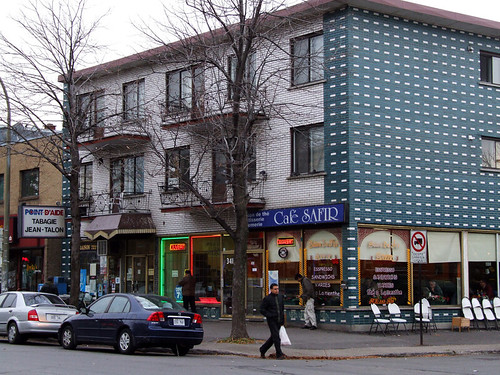
Each Monday, Spacing will bring you some of the popular posts from our sister blog, Spacing Montréal. We’ll keep an eye open for topics and discussions that are pertinent to current public space issues in Toronto.
• In Montréal’s postwar neighbourhoods, we see the new city — devoid of horse-drawn carriages and t-shirt shops. These developments represent what might best be described as the most Toronto-like parts of Montréal.
• Je fais mon Steinberg examines Montréal’s Mirvish equivalent, the Steinberg family, and asks a prudent question: “at what point does a privately-owned business…become a public space?” (After all, it’s impossible to think about Bloor and Bathurst without picturing Honest Ed’s.)
• Christopher DeWolf digs down in What we lost to the Ville-Marie Expressway to explore neighbourhoods and landmarks eradicated during construction of the Montréal highway in the late 1960s. To Toronto, it’s what the Gardiner is — and, more importantly, what the Spadina expressway would have been.


7 comments
Actually its very possible to imagine Bathurst and Bloor without Honest Eds. Probably sooner than we think. I wont miss it.
The Mirvish-Steinberg comparison doesn’t really work as a question of geography — what mattered to Montreal and, don’t forget, to Quebec more broadly about the Steinbergs wasn’t any particular physical place, but the cultural phenomenon they represented. There were many Steinbergs, but none iconic; there is one Honest Eds, and it is indeed iconic.
On the other hand, the comparison works well as a question of cultural icons. They’re pretty similar: the figure of the Jewish immigrant merchant who built up an empire from nothing, all the time remaining close to the popular masses and retaining a special place in their hearts. (In the Steinbergs’ case, nest captured in the Rad-Can miniseries a good decade or so ago.)
Perhaps it might be useful to triangulate the comparison by adding another Jewish merchant name: Sniderman. Now, here’s a case where there were many Sam The Record Mans *and* an iconic central store–and lest we forget, this past year is when said central store (and most particularly its sign) became Case In Point #1 re the privately-owned business/public space debate…
Nice.
Steinberg had a large building in downtown Windsor that sat vacant for the first half of my life then was torn down and is now the new Police Station. But “the steinberg building” was certainly a ghost-like presence in W.O.
It’s true, many in Quebec forget (or never knew of) Steinbergs’ ill-fated attempt to move beyond Quebec (and Ottawa).
I assume that in Windsor Steinbergs was seen as just some store (and ghost-like presence, I guess), rather than the kind of “Montreal’s Mirvish” described in the Montreal Mondays?
(For what it’s worth, most of the Montreal Steinbergs grocery stores moved right on as Metros and Provigos, and continue to operate in that capacity.)
The Steinberg’s chain in Ontario largely became Miracle Food Marts (anyone remember that chain, along with the UltraMarts that predated Loblaws and Wal-Mart Superstores?). They were picked up by A&P and in Toronto, became Dominion stores.
On topic, an older Spacing Wire post:
https://spacing.ca/toronto/?p=1618